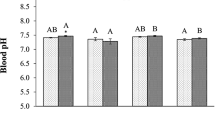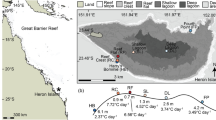Abstract
Amphipods living at the underside of Arctic sea ice are exposed to varying salinities due to freezing and melting, and have to cope with the resulting osmotic stress. Extracellular osmotic and ionic regulation at different salinities, thermal hysteresis, and supercooling points (SCPs) were studied in the under-ice amphipod Apherusa glacialis. The species is euryhaline, capable to regulate hyperosmotically at salinities S R < 30 g/kg, and osmoconforms at salinities S R ≥ 30 g/kg. Hyperosmotic regulation is an adaptation to thrive in low-salinity meltwater below the ice. Conforming to the ambient salinity during freezing reduces the risk of internal ice formation. Thermal hysteresis was not observed in the haemolymph of A. glacialis. The SCP of the species was −7.8 ± 1.9°C. Several ions were specifically downregulated ([Mg2+], [SO4 2−]), or upregulated ([K+], [Ca2+]) in comparison to the medium. Strong downregulation of [Mg2+], is probably necessary to avoid an anaesthetic effect at low temperatures.

Similar content being viewed by others
References
Aarset AV (1991) The ecophysiology of under-ice fauna. Polar Res 10:309–324
Aarset AV, Aunaas T (1987a) Osmotic responses to hyposmotic stress in the amphipods Gammarus wilkitzkii, Onisimus glacialis and Parathemisto libellula from Arctic waters. Polar Biol 7(4):189–193
Aarset AV, Aunaas T (1987b) Physiological adaptations to low temperature and brine exposure in the circumpolar amphipod Gammarus wilkitzkii. Polar Biol 8(2):129–133
Aarset AV, Aunaas T (1990) Metabolic responses of the sympagic amphipods Gammarus wilkitzkii and Onisimus glacialis to acute temperature variations. Mar Biol 107:433–438
Aarset AV, Torres JJ (1989) Cold resistance and metabolic responses to salinity variations in the amphipod Eusirus antarcticus and the krill Euphausia superba. Polar Biol 9(8):491–497
Aarset AV, Zachariassen KE (1988) Low temperature tolerance and osmotic regulation in the amphipod Gammarus oceanicus from Spitsbergen waters. Polar Res 6:35–41
Arndt CE, Swadling KM (2006) Crustacea in Arctic and Antarctic sea ice: distribution, diet and life history strategies. Adv Mar Biol 51:197–315
Auel H, Werner I (2003) Feeding, respiration and life history of the hyperiid amphipod Themisto libellula in the Arctic marginal ice zone of the Greenland Sea. J Exp Mar Biol Ecol 296(2):183–197
Brodie DA, Halcrow K (1978) Hemolymph regulation to hyposaline and hypersaline conditions in Gammarus oceanicus. Experientia 34:1297–1298
Eicken H, Krouse HR, Kadko D, Perovich DK (2002) Tracer studies of pathways and rates of meltwater transport through Arctic summer sea ice. J Geophys Res 107(C10):8046. doi:10.1029/2000JC000583
Einarson S (1993) Effects of temperature, seawater osmolality and season on oxygen consumption and osmoregulation of the amphipod Gammarus oceanicus. Mar Biol 117:599–606
Frederich M, Sartoris FJ, Arntz WE, Pörtner HO (2000) Haemolymph Mg2+ regulation in decapod crustaceans: physiological correlates and ecological consequences in polar areas. J Exp Biol 203:1383–1393
Frederich M, Sartoris FJ, Pörtner HO (2001) Distribution patterns of decapod crustaceans in polar areas: a result of magnesium regulation? Polar Biol 24:719–723
Gow AJ, Tucker WB III (1990) Sea ice in the polar regions. In: Smith WO Jr (ed) Polar oceanography, Part A: physical science. Academic, San Diego, pp 47–122
Hochachka PW, Somero GN (2002) Biochemical adaptation. Mechanism and process in physiological evolution, Oxford University Press, New York
Kiko R, Kramer M, Spindler M, Wägele H (2008) Tergipes antarcticus (Gastropoda, Nudibranchia): distribution, life cycle, morphology, anatomy and adaptation of the first mollusc known to live in Antarctic sea ice. Polar Biol 31(11):1383–1395
Koop JHE, Grieshaber MK (2000) The role of ion regulation in the control of the distribution of Gammarus tigrinus (Sexton) in salt-polluted rivers. J Comp Physiol 170B:75–83
Lee RE, Constanzo JP (1998) Biological ice nucleation and ice distribution in cold-hardy ectothermica animals. Annu rev Physiol 60:55–72
Macnaughton MO, Thormar J, Berge J (2007) Sympagic amphipods in the Arctic pack ice: redescriptions of Eusirus holmii Hansen, 1887, Pleusymtes karstensi (Barnard, 1959). Polar Biol 30(8):1013–1025
Mantel LH, Farmer LL (1983) Osmotic and ionic regulation. In: Mantel LH (ed) The biology of Crustacea: internal anatomy and physiological regulation, vol 5. Academic, New York, pp 53–161
Millero FJ, Feistel R, Wright DG, McDougall TJ (2008) The composition of standard seawater and the definition of the reference-composition salinity scale. Deep Sea Res 55(1):50–72
Morrit D, Spicer JI (1993) A brief re-examination of the function and regulation of extracellular magnesium and its relationship to activity in crustacean arthropods. Comp Biochem Physiol 106A:19–23
Morrit D, Spicer JI (1998) The physiological ecology of talitrid amphipods: an update. Can J Zool 76:1965–1982
Normant M, Kubicka M, Lapucki T, Czarnowski W, Michalowska M (2005) Osmotic and ionic haemolymph concentrations in the Baltic Sea amphipod Gammarus oceanicus in relation to water salinity. Comp Biochem Physiol 141A:94–99
Olsen TM, Duman JG (1997) Maintenance of the supercooled state in overwintering pyrochroid beetle larvae, Dendroides canadensis: role of hemolymph ice nucleators and antifreeze proteins. J Comp Physiol B 167(2):105–113
Poltermann M, Hop H, Falk-Petersen S (2000) Life under Arctic sea ice—reproduction strategies of two sympagic (ice-associated) amphipod species, Gammarus wilkitzkii and Apherusa glacialis. Mar Biol 136(5):913–920
Rakusa-Suszczewski S, McWhinnie MA (1976) Resistance to freezing by Antarctic fauna: supercooling and osmoregulation. Comp Biochem Physiol A 54:291–300
Renault D, Salin C, Vannier G, Vernon P (2002) Survival at low temperatures in insects: what is the ecological significance of the supercooling point? Cryo Letters 23(4):217–228
Robertson JD (1949) Ion regulation in some marine invertebrates. J Exp Biol 38:182–200
Robertson JD (1960) Osmotic and ionic regulation. In: Waterman TH (ed) The physiology of Crustacea, vol I. Academic, New York, pp 317–339
Sinclair BJ, Sjursen H (2001) Cold tolerance of the Antarctic springtail Gomphiocephalus hodgsoni (Collembola, Hypogastruridae). Antarct Sci 13(3):271–279
Soucek DJ (2007) Bioenergetic effects of sodium sulfate on the freshwater crustacean, Ceriodaphnia dubia. Ecotoxicology 16:317–325
Soucek DJ, Kennedy AJ (2005) Effects of hardness, chloride, and acclimation on the acute toxicity of sulfate to freshwater invertebrates. Environ Toxicol Chem 24(5):1204–1210
Waller CL, Worland MR, Convey P, Barnes DKA (2006) Ecophysiological strategies of Antarctic intertidal invertebrates faced with freezing stress. Polar Biol 29:1077–1083
Walters NJ, Uglow RF (1981) Haemolymph magnesium and relative heart activity of some species of marine decapod crustaceans. J Exp Mar Biol Ecol 55:255–265
Werner I, Auel H (2005) Seasonal variability in abundance, respiration and lipid composition of Arctic under-ice amphipods. Mar Ecol Prog Ser 292:251–262
Werner I, Gradinger R (2002) Under-ice amphipods in the Greenland Sea and Fram Strait (Arctic): environmental controls and seasonal patterns below the pack ice. Mar Biol 140(2):317–326
Werner I, Martinez Arbizu P (1999) The sub-ice fauna of the Laptev Sea, the adjacent Arctic Ocean in summer 1995. Polar Biol 21(2):71–79
Acknowledgments
We thank captain and crew of RV “Polarstern” and chief scientist Ursula Schauer for their constant support during ARK XXII/2. We furthermore thank Franz-Josef Sartoris for help with the determination of ion concentrations and for general discussion and three anonymous reviewers for critical comments on the manuscript.
Author information
Authors and Affiliations
Corresponding author
Rights and permissions
About this article
Cite this article
Kiko, R., Werner, I. & Wittmann, A. Osmotic and ionic regulation in response to salinity variations and cold resistance in the Arctic under-ice amphipod Apherusa glacialis . Polar Biol 32, 393–398 (2009). https://doi.org/10.1007/s00300-008-0531-z
Received:
Revised:
Accepted:
Published:
Issue Date:
DOI: https://doi.org/10.1007/s00300-008-0531-z




